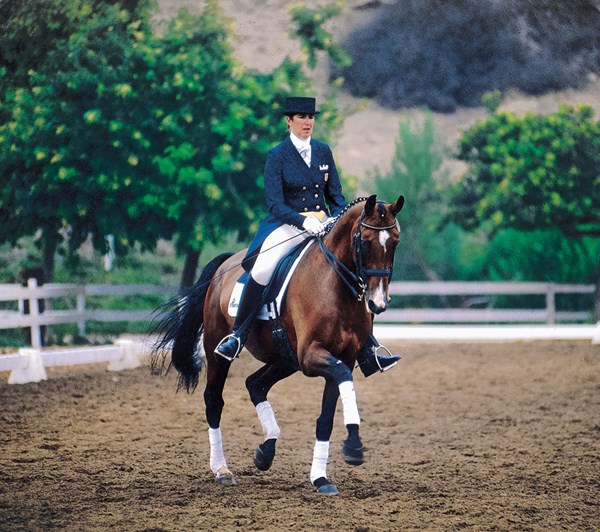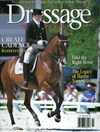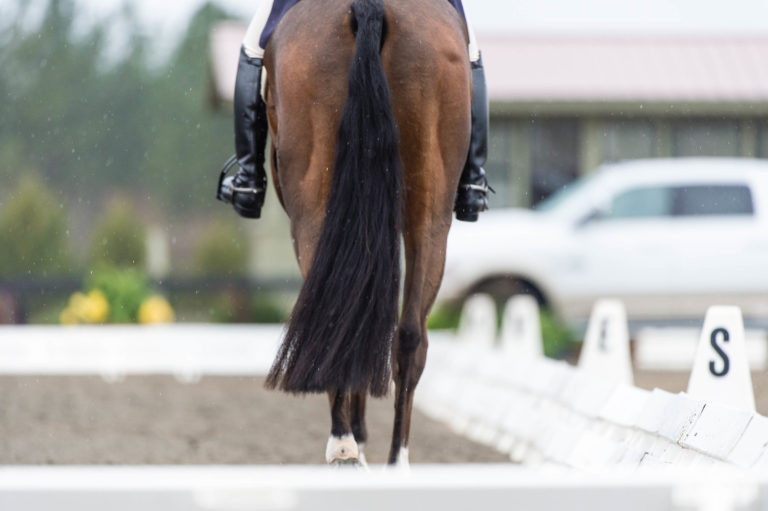A horse with cadence is athletic and light on his feet. He looks and feels as if he’s dancing. That cadence, or “marked accentuation of the rhythm,” makes him move with more expression.

You create cadence by developing the gait, starting with the distinct two-beat rhythm of the working trot or the three-beat rhythm of the canter. You add power, increasing the moment of suspension and making the beat more defined. The word “power” reminds me of the horse’s hindquarters—the source of power that develops cadence.
Cadence: The marked accentuation of the rhythm and (musical) beat that is a result of a steady and suitable tempo harmonizing with a springy impulsion—USDF Glossary of Dressage Judging Terms
Some horses have natural cadence because they are loose in their backs and have more suspension by nature. For these horses, collection is easier because they’re naturally engaged so the rider doesn’t have to work hard to consciously develop it.
In this article, I’ll show you several ways to help your horse develop or improve his cadence in the trot. The first exercise is over cavelletti. The next two exercises are in a circle and on a straight line, during which you’ll ask your horse to go forward and then collect. These exercises can be tailored to help your horse’s canter, too.
Before beginning, take a careful look at your horse’s training. If he isn’t ready for collection work, stick with my preliminary cavelletti exercises in the working paces. (For additional cavalletti work, see “Develop a Working Pace Attitude,” DT, April ’00.) It’s also worth mentioning, before beginning, that in my mind, cadence doesn’t refer to the walk. There’s no cadence in the walk because there is no period of suspension. If there is, it’s not a correct walk.
Building Blocks to Cadence
Before starting the exercises for developing cadence, check that you have two basic qualities: a correct, rhythmic working trot and an effective half halt. Let’s look at each prerequisite.
1. A rhythmic working trot will lay the foundation for further development of the gaits. When you begin your ride, concentrate on developing a definite rhythm—first in the rising trot so it’s easier for your horse’s back to come up underneath you. Close your legs so his hind legs keep coming under as you rise.
After you’ve warmed up in each direction, go to sitting trot. When you changed from rising to sitting, did your horse’s rhythm change? Did his frame or the connection change? If so, immediately return to rising again. Repeat the sequence: Rise and sit, rise and sit. Soon your horse will be able to maintain the same rhythm, freedom, frame and connection whether you’re rising or sitting. Going from rising to sitting helps maintain the rhythm and develop greater freedom and throughness. Eventually you’ll want to do all of your trot work sitting, but many horses aren’t strong enough in the beginning to carry a rider very long.
If your horse is not very strong, then continue to work on this basic rising–sitting trot exercise, but hold off on anything that requires collection for now. When your horse becomes strong enough to maintain quality rhythm as you sit, you can expect to have an effective half halt and more influence from your seat.
2. In addition to this forward attitude in the working trot sitting, a basic half halt must be established so that you can develop collection and the resulting cadence in the trot. To half halt, sit deep, close both upper thighs and both hands, emphasizing the outside hand. Your horse will become more active behind and engaged.
If you bring your lower leg back more than usual, it will emphasize the need for quickness behind. You want your horse to be soft and steady in the hand after the half halt. If your horse is dropping the bit, his back may be tight. If he’s pulling, his hind legs probably aren’t engaged.
Because of your established basics, your horse will work through the levels, become stronger and be able to carry himself with more and more expression. A Training Level horse does not have the strength for the cadence of a Grand Prix horse, but he can have the basic building blocks for the development of it. If you’ve passed the tests so far, here are three exercises I use to improve cadence.
Cavelletti Exercise
I use cavalletti with young horses to establish a good beat in the trot. The cavalletti alone add more cadence to some horses with a flat stride. They teach your horse what you want, and they also give you the feeling of cadence. For this exercise, use between five and eight cavalletti or as many as you have (see images below). If your horse is new to going over cavalletti, start with them at their lowest setting. Set them in a straight line, the proper distance for your horse’s stride. The distance between the cavalletti for trot is between 4 feet 2 inches and 5 feet. By gradually moving the cavalletti in or out, determine the correct distance that suits your horse’s stride.
Ride over the cavalletti, doing the same rising and sitting trot exercise that you worked on to establish the rhythmic working trot until your horse stays round, on the bit and in the same frame. Feel the rhythm of your horse’s defined steps. It’s a nice feeling. The horse’s stomach muscles lift, and you can feel his back come up under you. Your goal is to get this feeling without the cavalletti.
Place the poles on an arc. Go through the middle of the poles or slightly to the outside. Then sit to the trot, and guide your horse through the inner portion of the poles where the distance is shorter. This will encourage your horse to lift and carry his weight instead of pushing off.
With the cavalletti straight or on an arc, raise them slightly. The added height will give your horse even more airtime and cadence. When you are very confident going over the cavelletti on a straight line, put them on a 15-meter circle. The space between the cavalletti will be smaller on the inner side of the poles. To ride through the cavalletti:
1. Clearly define where you are going through them by mentally dividing the poles in half. First go through the center of the cavalletti. As you go through them, get a good rhythm in the rising trot until it feels like a normal, natural stride. Then ride slightly to the outside of the poles.
2. As your horse’s rhythm becomes confirmed, go to the sitting trot. Sitting at this point will help you and him with the rhythm and enable you to help your horse collect.
3. Next, spiral the circle slightly to the inner side of the cavalletti. This will encourage your horse to collect his trot. To do this, he has to take shorter, more elevated strides. Establish cadenced collection in one direction, and then change direction.
4. Finally, raise the cavalletti so that they are slightly off the ground. This will give your horse even more elevation and cadence.
Forward-and-Back Exercises
Going forward and back adds power and lift to your horse’s collection by transforming pushing power into carrying power. This develops cadence. Within the dressage tests, there are invitations to improve carrying power and cadence. In Fourth Level, Test 1, you ride a medium trot on the diagonal, do a transition back to collected trot at X for a few strides and then ride a medium trot to the end of the diagonal. This is intended to help you and your horse reestablish balance halfway through the diagonal and to get your horse engaged and in a good position to push off again.
However, horses and riders rarely execute this exercise well. As preparation, you can ride this exercise first on a circle and then on the long side (see photos at right).
Exercise 1: Forward and Back on a Circle
1. Start by riding a medium trot on a 20-meter circle. Each time you reach the centerline opposite C or A, ask for a few strides of shoulder-fore to collect him. Also, any time your horse starts to feel unbalanced, you can bring him back to collection. Then ask him for a medium trot again. Repeat.
The exercise may not feel good at first because riding the medium trot on a 20-meter circle is difficult. However, riding it will get your horse engaged, making it easier and much improved when you try it on a straight line.
Exercise 2: Forward and Back on a Straight Line
1. Start at C, traveling to the right. As you approach M, ride shoulder-fore. Half halt with your outside rein and close your inside leg. Maintain the passive outside leg back so the haunches don’t swing out.
2. After M, straighten your horse and ask for five or six strides of medium trot. Close both legs and lighten your hands.
3. A few strides before B, bring your horse back to shoulder-fore. Sit into him more, deepen your seat, use your inside leg and half halt with your outside rein.
4. At B, ride a 10-meter circle. This is especially useful if your horse is difficult to bring back to shoulder-fore.
5. After returning to B, maintain the shoulder-fore for about three strides after completing the circle.
6. Ask for medium trot again for five or six strides.
7. Before F, return to shoulder-fore.
After repeating this exercise several times, your horse will step under automatically and maintain lightness in your hand when you bring him back.
The ultimate step is to ask for the medium trot but not allow it. Instead of actually performing a medium, keep him collected. That is, ask for a medium, but don’t let him go out the front. You’ll push for more, but half halt to keep the trot together in collection.
The result will be a more expressive, cadenced and collected trot with more life underneath you—maintaining the engagement and the lightness in front.
Challenges
As you ride the exercises, keep in mind that you may encounter some of the following challenges:
1. Sometimes the trot becomes cadenced, but it’s through tension. Then your horse’s back gets tighter because he isn’t engaged. You want the suspension to be created out of relaxation and engagement, not out of tension.
It’s very important to keep your horse’s back relaxed throughout the process, which is why you might have to go back to the rising trot often so your seat isn’t driving his back down. Use of cavalletti encourages your horse to use his back in a relaxed way.
2. Cadence at the expense of thoroughness is power without honest connection. Your horse has to be through, supple in the connection, bendable left and right and able to be collected.
To improve throughness, I do a lot of work on a circle and also ride shoulder-in, which automatically gets my horse to step under with his inside hind leg, coming from behind.
3. Sometimes a horse will trip and crash through the cavalletti because he isn’t aware of where his feet are or because the rider lost his balance. Just try again. Be sure you aren’t asking for too big a trot or too small a trot by placing the cavalletti too far apart or too close together. Set the cavalletti so they are a natural stride for your horse.
4. Perhaps your horse loses bend, softness in the hand or forwardness to the bit. If he backs off and isn’t in front of your leg, refresh the working paces until he is honest.
By patiently riding these exercises and working on the challenges you’ll encounter, your horse will improve his rhythm and develop cadence. And then you will feel as if the two of you are dancing.
Kathleen Raine is a two-time Olympic dressage competitor, FEI Nations Cup Silver medalist and FEI World Games Bronze medalist. Kathleen and her husband, David Wightman, own and operate Adventure Farms training facility in Murrieta, California.

This article was first published in the March 2001 issue of Dressage Today.
Editor’s note: The images in this article are from 2001. Today, DT requires all subjects in the magazine to wear safety helmets.











